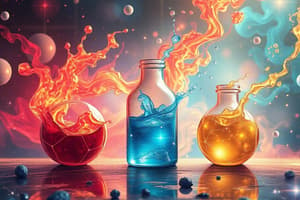Podcast
Questions and Answers
Energy is the ability to do ______.
Energy is the ability to do ______.
work
______ energy is stored energy.
______ energy is stored energy.
Potential
Waves that travel perpendicular to the motion are called ______ waves.
Waves that travel perpendicular to the motion are called ______ waves.
transverse
During spring tides, the ocean experiences ______ tides.
During spring tides, the ocean experiences ______ tides.
The ______ is the layer of Earth that includes both the oceanic and continental crust.
The ______ is the layer of Earth that includes both the oceanic and continental crust.
Photosynthesis converts light energy into ______ energy.
Photosynthesis converts light energy into ______ energy.
In the rock cycle, ______ rocks are formed from cooled and solidified magma.
In the rock cycle, ______ rocks are formed from cooled and solidified magma.
Conservation aims to protect resources by using them ______ and preserving them.
Conservation aims to protect resources by using them ______ and preserving them.
In a ______, particles are tightly packed and have a definite shape and volume.
In a ______, particles are tightly packed and have a definite shape and volume.
A ______ is made up of a single type of atom and is represented by a chemical symbol.
A ______ is made up of a single type of atom and is represented by a chemical symbol.
A ______ is created when two or more different atoms are chemically combined.
A ______ is created when two or more different atoms are chemically combined.
Oil has a ______ density compared to water and honey.
Oil has a ______ density compared to water and honey.
An example of a ______ change is ice melting into water, which can be reversed.
An example of a ______ change is ice melting into water, which can be reversed.
Gravity is a force that ______ objects towards each other.
Gravity is a force that ______ objects towards each other.
Balanced forces result in a net force of ______ and cause no change in motion.
Balanced forces result in a net force of ______ and cause no change in motion.
Newton's 3rd Law of Motion states that for every action, there is an equal and opposite ______.
Newton's 3rd Law of Motion states that for every action, there is an equal and opposite ______.
Flashcards
Potential Energy
Potential Energy
Stored energy that has the potential to do work.
Kinetic Energy
Kinetic Energy
Energy in motion, doing work.
Photosynthesis
Photosynthesis
The process by which plants convert light energy into chemical energy (sugar) using carbon dioxide and water.
Transverse Wave
Transverse Wave
Signup and view all the flashcards
Longitudinal Wave
Longitudinal Wave
Signup and view all the flashcards
Earth's Layers
Earth's Layers
Signup and view all the flashcards
Sedimentary Rock
Sedimentary Rock
Signup and view all the flashcards
Conservation
Conservation
Signup and view all the flashcards
Solid
Solid
Signup and view all the flashcards
Liquid
Liquid
Signup and view all the flashcards
Gas
Gas
Signup and view all the flashcards
Element
Element
Signup and view all the flashcards
Compound
Compound
Signup and view all the flashcards
Homogeneous Mixture
Homogeneous Mixture
Signup and view all the flashcards
Heterogeneous Mixture
Heterogeneous Mixture
Signup and view all the flashcards
Physical Change
Physical Change
Signup and view all the flashcards
Study Notes
States of Matter
- Matter exists in three fundamental states: solid, liquid, and gas.
- Solids have a definite shape and volume.
- Liquids have a definite volume but take the shape of their container.
- Gases have neither a definite shape nor a definite volume.
Pure Substances
- Pure substances are made up of only one type of element or compound.
- Elements are made up of identical atoms.
- Compounds are made up of two or more elements combined chemically.
Mixtures
- Mixtures are combinations of two or more substances in which each substance retains its individual properties.
- There are homogeneous and heterogeneous mixtures.
- Homogeneous mixtures have a uniform composition throughout, meaning every part of the mixture has the same properties.
- Heterogeneous mixtures have a non-uniform composition, meaning different parts of the mixture have different properties.
Metals
- Metals are typically good conductors of heat and electricity, are ductile (can be drawn into wires), malleable (can be hammered into sheets), have high density, and are usually not brittle.
- Metals are typically solids at room temperature.
Nonmetals
- Nonmetals are typically poor conductors of heat and electricity.
- Nonmetals are not ductile or malleable; they are often brittle.
- Nonmetals often have a low density.
- Nonmetals can exist as solids, liquids, or gases at room temperature..
Metalloids
- Metalloids have properties of both metals and nonmetals.
- Metalloids are sometimes semi-conductors of heat and electricity.
Density
- Density is a measure of how much mass is contained in a given volume.
- Less dense objects float on top of more dense objects in liquids.
Physical Change
- A physical change alters the state or form of a substance without changing its chemical composition.
- Examples include changes in state (melting, freezing, vaporization), changes in shape, and dissolving.
Chemical Change
- A chemical change alters the chemical composition of a substance.
- Examples include burning, rusting, and reacting.
Forces and Motion
- Force is a push or a pull that can cause an object to move, stop moving, or change direction.
- Friction is a force that opposes motion between two surfaces in contact.
- Gravity is a force that pulls objects towards each other.
Energy
- Energy is the ability to do work.
- Potential energy is stored energy.
- Kinetic energy is energy of motion.
- Different types of energy include mechanical, electrical, chemical, thermal, light, and sound.
Energy Transfer
- Energy can be transferred from one object to another or from one form to another.
- Energy transfer can occur across systems or objects (like in food chains).
Waves
- Waves transmit energy through a medium or space.
- Transverse waves vibrate perpendicular to the direction of wave motion.
- Longitudinal waves vibrate parallel to the direction of wave motion.
Earth's Seasons
- Earth's orbit around the sun and its tilt causes seasonal changes on earth.
Tides
- Tides are the rise and fall of sea levels caused by the gravitational pull of the moon and sun.
Earth's Spheres
- The Earth is made up of four main spheres: geosphere (Earth's land), atmosphere (air), hydrosphere (water), and biosphere (life).
Rock Cycle
- The rock cycle describes the processes that transform rocks from one type to another.
- Processes include melting, cooling, weathering, erosion, compaction, and cementation.
Conservation
- Conservation involves using resources responsibly and preserving them for future generations.
- Ways to conserve resources include efficiency, technology, and changes in individual behavior.
Studying That Suits You
Use AI to generate personalized quizzes and flashcards to suit your learning preferences.




